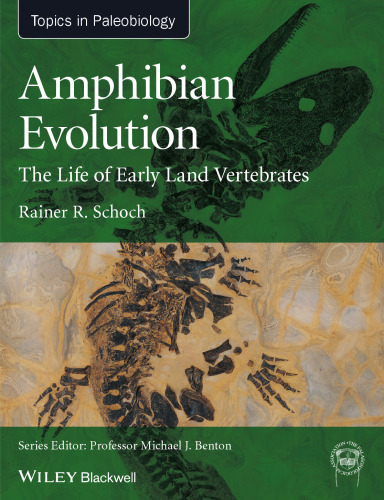Description
Amphibian Evolution: The Life of Early Land Vertebrates by Rainer R. Schoch, ISBN-13: 978-0470671788
[PDF eBook eTextbook] – Available Instantly
- Publisher : Wiley-Blackwell
- Publication date : May 5, 2014
- Edition : 1st
- Language : English
- 304 pages
- ISBN-10 : 0470671785
- ISBN-13 : 978-0470671788
NOTE: This book is a standalone book and will not include any access codes.
This book focuses on the first vertebrates to conquer land and their long journey to become fully independent from the water. It traces the origin of tetrapod features and tries to explain how and why they transformed into organs that permit life on land. Although the major frame of the topic lies in the past 370 million years and necessarily deals with many fossils, it is far from restricted to paleontology. The aim is to achieve a comprehensive picture of amphibian evolution. It focuses on major questions in current paleobiology: how diverse were the early tetrapods? In which environments did they live, and how did they come to be preserved? What do we know about the soft body of extinct amphibians, and what does that tell us about the evolution of crucial organs during the transition to land? How did early amphibians develop and grow, and which were the major factors of their evolution?
The Topics in Paleobiology Series is published in collaboration with the Palaeontological Association, and is edited by Professor Mike Benton, University of Bristol.
Table of Contents:
Copyright
Contents
Preface
Acknowledgments
1 Introduction
1.1 Changing paradigms in amphibian evolution
1.2 Paleobiology: data, methods, and time scales
1.3 Concepts and metaphors: how scientists “figure out” problems
1.4 Characters and phylogenies
1.5 What’s in a name?
References
2 The Amphibian World: Now and Then
2.1 Tetrapoda
2.1.1 The tetrapod skeleton
2.1.2 Tetrapod characters
2.1.3 Stem-tetrapods (Tetrapodomorpha)
2.1.4 Carboniferous tetrapods or tetrapodomorphs?
2.2 The amniote stem-group
2.2.1 Anthracosauria
2.2.2 Seymouriamorpha
2.2.3 Chroniosuchia
2.2.4 Lepospondyli
2.2.4.1 Lepospondyl characters
2.2.4.2 Microsauria
2.2.4.3 Lysorophia
2.2.4.4 Nectridea
2.2.4.5 Aïstopoda
2.2.4.6 Adelospondyli
2.2.4.7 Acherontiscidae
2.2.5 Gephyrostegida
2.2.6 Amniota
2.2.6.1 Stem-amniotes and early crown amniotes
2.3 The lissamphibian stem-group (Temnospondyli)
2.3.1 Edopoidea
2.3.2 Dendrerpeton and Balanerpeton
2.3.3 Dvinosauria
2.3.4 Dissorophoidea and Zatracheidae
2.3.5 Eryopoidea
2.3.6 Stereospondyli
2.4 Albanerpetontidae
2.5 Lissamphibia
2.5.1 Lissamphibian characters
2.5.2 Batrachia
2.5.2.1 Anura (frogs and toads)
2.5.2.2 Caudata (salamanders)
2.5.2.3 Gymnophiona (caecilians)
References
3 Amphibian Life Through Time
3.1 Aquatic predators prepare for land
3.2 Hot springs, scorpions, and little creepers
3.3 Life in the tropical coal forest
3.4 Neotenes explore unfavorable waters
3.5 Lowlands, uplands, and a cave
3.6 Hide and protect: extreme life in the hothouse
3.7 Predators in deltas, lakes, and brackish swamps
3.8 Stereospondyls in refugia, lissamphibians on the rise
3.9 Batrachians diversify, stereospondyls disappear
3.10 Lissamphibians expand into diverse habitats
References
4 The Amphibian Soft Body
4.1 How to infer soft tissues in extinct taxa
4.2 Fossil evidence: soft tissue preservation
4.3 Head and visceral skeleton
4.4 Respiratory organs
4.5 Lateral lines, electroreception, and ears
References
5 Evolution of Functional Systems
5.1 How paradigms and brackets give a functional scenario
5.2 Feeding and breathing under water
5.3 Decoupling breathing and feeding
5.4 Hearing: exapting the spiracle and hyomandibula
5.5 Respiration in early tetrapods
5.6 The evolution of terrestrial feeding
5.7 Transforming fins into limbs
5.8 Locomotion of Paleozoic tetrapods
References
6 Development and Evolution
6.1 Ontogeny in modern amphibians
6.2 Fossil ontogenies
6.3 Ontogeny as a sequence: developmental trajectories
6.4 Histology: the skeleton as archive
6.5 Changing shape: allometry
6.6 Heterochrony: the evolution of development
6.7 Body plans: gene regulation and morphogenesis
References
7 Paleoecology
7.1 Lissamphibian ecology
7.2 Paleoecology: problems and perspectives
7.3 Paleozoic and Mesozoic amphibians
7.4 Amphibian evolution as a walk through trophic levels
References
8 Life History Evolution
8.1 Plasticity, reaction norm, and canalization
8.2 Reaction norms in extant amphibians
8.3 The biphasic life cycle in lissamphibians
8.4 Seymouriamorphs: biphasic life cycles without metamorphosis
8.5 Temnospondyls: flexible uni- and biphasic ontogenies
8.6 Lepospondyls: dwarfism and uniphasic life cycles
8.7 The evolution of metamorphosis
8.8 The evolution of neoteny
8.9 General features of life history evolution
References
9 Phylogeny
9.1 Phylogeny of amphibians
9.2 The big picture: tetrapod diversification
9.3 The origin of lissamphibians
References
10 Macroevolution
10.1 What is macroevolution?
10.2 Patterns of early tetrapod evolution
10.3 Major factors of amphibian evolution
10.4 Clades, space, and time
10.5 Diversity, disparity, and extinction
10.6 The evolution of terrestriality
References
Index
Supplementary Images
What makes us different?
• Instant Download
• Always Competitive Pricing
• 100% Privacy
• FREE Sample Available
• 24-7 LIVE Customer Support




